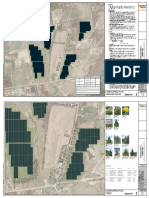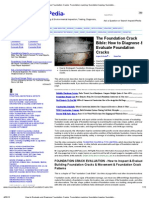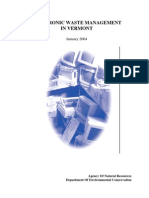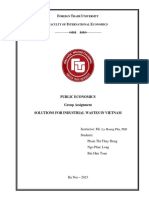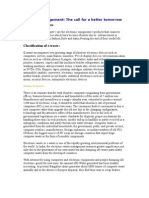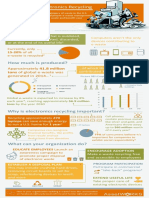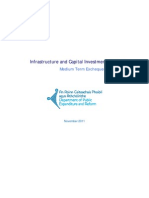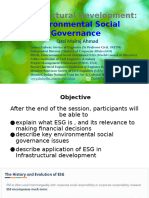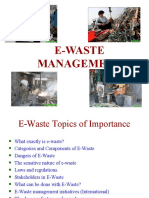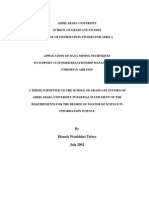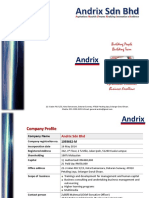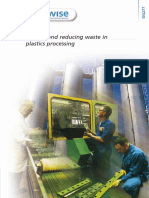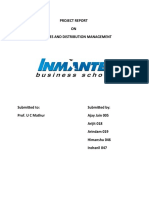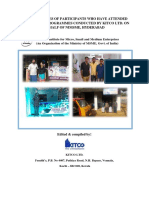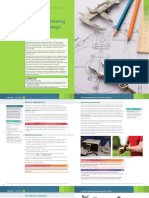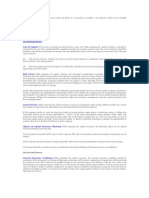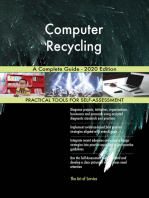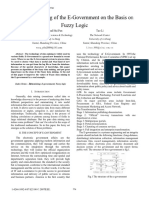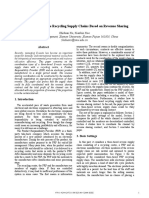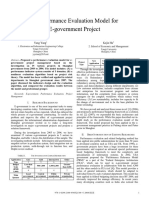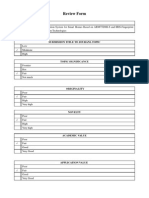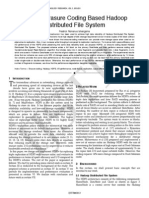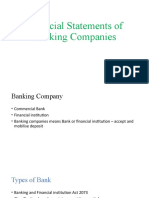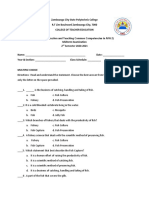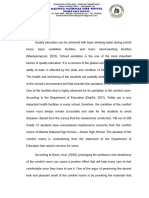Ewaste Business Model
Ewaste Business Model
Uploaded by
Fredrick IshengomaCopyright:
Available Formats
Ewaste Business Model
Ewaste Business Model
Uploaded by
Fredrick IshengomaOriginal Description:
Original Title
Copyright
Available Formats
Share this document
Did you find this document useful?
Is this content inappropriate?
Copyright:
Available Formats
Ewaste Business Model
Ewaste Business Model
Uploaded by
Fredrick IshengomaCopyright:
Available Formats
E-waste Business Model, Policies and
Regulations in India
Amit Jain1
Abstract E-waste business model evolves from recycling
industry operating under policy and regulatory framework in a
country. In India, environmental policy and regulatory
framework is emerging from pollution control to pollution
prevention with an increasing implementation of business model
under public private partnership. In this context, an assessment
of conventional E-waste recycling under the existing regulatory
and emerging extended producer responsibility (EPR) regime
with an option of public private partnership (PPP) as an interim
intervention in the state of Maharashtra has been carried out.
Further, mechanism of its establishment and operation both
during short and long term have been identified for complete
transition to EPR based regulatory regime.
Maharashtra was identified as the next step during 2006-07
[2]. An assessment of viable business model for the E-waste
recycling facility consisting of conventional E-waste recycling
under the existing regulatory regime and extended producer
responsibility (EPR) regime with an option of public private
partnership (PPP) as an interim intervention was carried out
considering current and emerging policy and regulatory
regime in the country. The objective of this assessment was to
concurrently identify a combination of viable policy,
regulatory and market based interventions for establishing
environmentally sound recycling infrastructure for E-waste
management.
I. INTRODUCTION
II. APPROACH AND METHODOLOGY
-waste has grown as a major waste stream in India during
current decade. Year 2005, national level E-waste
generation estimate is about 146180 tons per year, which
is expected to exceed 400,000 tons per year by 2011 [1].
Geographically, Mumbai Metropolitan Region (MMR) and the
state of Maharashtra had been identified as the highest Ewaste generator in the country with current projections
ranging from 18,963 tons to 137,417 tons in MMR and from
56,901 tons to 292,157 tons in Maharashtra till 2020 [2].
Indian scrap and E-waste recycling industry mapping using
tracer technique indicated that E-waste recycling
infrastructure in MMR region consists of E-waste dismantlers
in informal sector, who are linked to informal metal recyclers
operating in other cities in India [2] [3]. These operations are
leading to emissions of toxics, occupational hazards,
economic losses and leakage due to inefficient management
and recycling of E-waste. The geographical distribution of
informal sector recycling industry over a vast area without
organized E-waste collection and transportation system leads
to inefficient E-waste management resulting in economic
losses due to loss of material in the material flow chain.
Further, the toxic footprint and occupational hazard also gets
geographically distributed whose intensity depends on the
scale and extent of recycling [4]. Therefore, strengthening of
policy and regulatory regime and creation of compliant Ewaste recycling infrastructure, which can arrest and control the
geographical distribution of toxic footprint, has been identified
as the primary need for E-waste management in a given
geographical region. In this context, establishment of a
scientifically designed E-waste recycling facility in
At first, existing policy and regulatory regime was reviewed
and evaluated in terms of expected future trends. This
evaluation is followed by identification of business risks.
These risks have been quantified and used for sensitivity
analysis of different recycling scenarios based on parameters
like internal Rate of Return (IRR) and Net Present Value
(NPV) obtained from cash flow analysis to arrive at optimum
scale of E-waste management operations. The next step
included summary mapping of the sensitivity analysis
versus the three business models under the discussed
regulatory regime. Further, standard strategic evaluation
technique of Strength, Weakness, Opportunities and Threat
(SWOT) analysis has been used to identify the business model
for implementation.
1
Author is with IRG Systems South Asia Pvt. Ltd., 103 Thapar House,
Community Centre, Gulmohar Enclave, New Delhi, 110049, India. phone: 9111-41759510; fax:91-11-41759514; e-mail:amit@irgindia.com
III. RESULTS AND DISCUSSIONS
Year 2005 E-waste inventory generation trends shown in Fig.
1 indicate significant increase in E-waste generation beyond
year 2011 resulting in six year period for policy and regulatory
interventions and establishment of E-waste management
infrastructure in the country [1]. An evaluation of policy and
regulatory environment shows declaration of National
Environment Policy in 2006 followed by publication of Ewaste guidelines in 2008 and amendment of Hazardous Waste
(Management, Handling and Transboundary Movement)
Rules [1] [5] [6]. National environment policy emphasizes
development of an action plan for development and
implementation of viable models of public-private
partnerships for setting up hazardous waste management
systems in India. E-waste was partly included in the schedule
IV of Hazardous Waste (Management, Handling and
Transboundary Movement) Rules 2008 [6]. The existing rules
require authorization from respective state pollution control
board under Air; Water Act and Hazardous Waste
(Management, Handling and Transboundary Movement)
Rules 2008 and environmental impact assessment (EIA)
clearance from ministry of environment and forest (MoEF),
Government of India for establishing E-waste recycling
facility. This regulatory intervention has triggered legal
establishment as a registered recycler of an E-waste
dismantling and recycling facility in India.
In Maharashtra, E-waste generation estimates from personal
computers (PC) is expected to increase from 9,135 tons in
2008 to 81,448 tons in 2020.The total E-waste generation from
PC in MMR is expected to increase from 5,260 tons in 2008 to
46,903 tons in 2020. Any recycling facility cannot be designed
on 100% E-waste capture rate of E-waste generation.
Assuming 50% E-waste capture efficiency, it is expected that
E-waste generation from Maharashtra will range from 4568
tons in 2008 to 40,724 tons in 2020. This provides the basis of
designing first and second level E-waste recycling facility at
MMR with a capacity of 5,000 tons per year during first phase
and an additional capacity addition of 5,000 tons per year
during second phase after two years. ELCINA, industry
associations
for
electronics
have
estimated
that
service/commercial sector accounts about 80% of the total
market penetration of computer and IT hardware in India.
ELCINAs report on consumers behavior for E-waste
summarize that at household level, 65% of the individuals
look for best monetary or exchange value for their old
products. Only 2% of individuals think of the impact on
environment while disposing off their old electrical and
electronic equipment. At corporate/ business level, 60% of the
companies/ offices look for best monetary value for their old
computers while only 6% of the organizations were found to
be disposing off their computers in environmentally friendly
manner. 11% of the replaced computers enter E-waste stream
through scrap dealers, 21% of the replaced computers enter Ewaste stream through second hand market while 48% of the
replaced computers enter E-waste stream exchange and buy
back scheme [7]. Therefore, the major E-waste items, which
are expected to drive the development (planning / design /
implementation) of E-waste management system in India will
be personal computers. Since 50% of the computers (E-waste)
replaced through exchange and buy back scheme lands up in
formal sector at the retail outlet, therefore, this quantity can be
easily captured and recycled in the formal sector. As the
chances of prevention of leakage are higher at the retail outlet
in the E-waste material flow chain, E-waste collection system
should start at this point. This analysis indicates that 50% Ewaste collection efficiency under B2B (Business to Business)
in service/commercial sector can initially support recycling
plant design capacity of 25 tons per day with 100% capacity
expansion in the fourth year and 100 tons per day in the tenth
year. Three types of E-waste collection mechanism at
household, commercial, corporate levels and in cyberspace
have been proposed to capture 50% E-waste considering
consumers preference to get the best value of their old
products. Initially, collection mechanism of recyclers will
drive the E-waste collection and transportation system to
minimize its leakage, which is expected to be gradually
supported by collection mechanism for households and
commercial sector under emerging EPR regime.
The proposed E-waste recycling system as per E-waste
guidelines will consist of first, second and third level of
treatment technology, where third level treatment is limited to
precious metal recovery. A gap analysis of treatment
technology indicates that precious metal recovery technology
from E-waste recycling is lacking in India. Option analysis of
smelting and hydrometallurgical based technology options,
which are available for precious metal recovery under the
existing circumstances in Maharashtra/India, has been carried
out and summarized in table 1. This analysis indicates that a
high capital intensive and large scale of operation is required
for smelting of E-waste fraction. Literature cites that one of
such facility in Europe has treated about 300,000 tons per
annum of input raw material and has posted 3.8 billion
turnover during year 2007 [8]. In this facility, E-waste is one
among 200 different types of input raw material and
contributes only 10 % of the total input. The input E-waste
raw material to such facility is in the form of printed circuit
board. It may be noted that even in the best of E-waste
collection scenario with 90% collection efficiency, India will
be able to generate about 3,60,000 tons of E-waste. If printed
circuit board constitutes about 10% of the E-waste collected
then only 36,000 tons of raw material is available for recycling
in the best case scenario. This amount is not adequate to
sustain smelting based metal recovery facility, which will
require other different types of metal waste along with Ewaste for recycling. Further, 90% E-waste collection
efficiency has not been achieved even in best of E-waste
management system elsewhere. In such scenario, if the
decision criteria are applied to only E-waste management in
India then second option of hydrometallurgical/
electrowinning for precious metal recovery appears to be
viable. Even in such scenario, the scale and timing of
establishment of such facility needs to be determined. This
will be linked to E-waste inventory and availability of raw
material.
Financial viability (IRR/NPV) for two scenarios with scenario
1 consisting of first and second level of treatment and scenario
2 consisting of first, second and third level treatment
considering business risks show week viability with IRR value
lower than 25% and a payback period of 9 to 10 years. The
project is most sensitive to land prices followed by interest
rates, customs duty, subsidy and octroi with an incremental
IRR improvement ranging from 5 % to 25 %. This analysis
also indicates that if lower quantities of PC are dismantled
then financial viability goes down significantly, thereby
recommending higher incentives to white goods recyclers.
Financial viability is also sensitive to input raw material and
output price fluctuations.
At operational level, conventional E-waste recycling model
and EPR based model are the two extreme models with PPP
model falling as an interim intervention [9] [10]. SWOT
analysis of both the extreme models shows that regulatory
intervention and government participation is required in their
implementation. Further, potential of leakage exists in all the
three models. Though EPR system offers the potential of
reduction of leakage of waste to informal sector, it is not
100% foolproof. The major difference in the implementation
of the two models is the money flow i.e. who pays
whom. In Indian context, the implementation of EPR system
will require a complete shift in consumer behavior.
Summary mapping of sensitivity analysis versus the three
models is shown in table 2. The mapping indicates that a clear
trade off is required between the government participation
in terms of land/ subsidy/ customs duty & octroi waiver/
income tax rebate/ interest rate rebate and input raw material
cost, rights to sell recovered material and recycling fee.
Further, the timing of this trade off is linked to time taken to
shift consumer behavior from money receiver to money
payer. This provides the basis for either supporting the
conventional recyclers for a particular time period or lead to
development of PPP model.
IV. CONCLUSIONS
The major factor for implementing PPP model is the level
of government participation, which can be in terms of
provision of land on concession basis and/ or equity
partnership. Further, user fee or service fee collected by
the government under this model can be in the form of annuity
transferred from the government to the recycling project
operator every year. The recovery of this fee can come either
from tax collected or from the revenue retained by the
company or a combination of both. The possible options for
levying this user fee can be the point of transaction/ sale,
which will prevent its leakage to informal sector. This will
also deter business/ commercial/ formal sector to sell E-waste
to informal sector. The collected user fee can be transferred to
a fund specially created for E-waste recycling, which is either
managed by the government agency or an independently.
Money from this fund can be transferred to the recycler as per
approved annuity, based on statement of accounts submitted
by the recycler to regulator. One of the major advantages of
this mechanism could be that this user fee can also be levied at
the time of sale of brand new electrical and electronic
equipment and transferred to the same fund in case of
implementation of EPR regime. The timing of this transfer
will be in line with PPP contract conditions, when government
entity prefers to exit from the model and transfers all its roles
and responsibilities to other entity in EPR regime. A rough
estimate of this exit has been estimated to be eight to ten years
in India. Therefore, PPP model can serve as a viable transition
mechanism to an EPR based regime for E-waste management
in Maharashtra and India.
REFERENCES
[1] Central Pollution Control Board (CPCB). Guidelines for
Environmentally Sound Management of E-Waste. CPCB,
Ministry of Environment & Forests, Delhi, India, 2008.
[2] Maharashtra Pollution Control Board, Report on
Assessment of Electronic Wastes in Mumbai Pune Area,
Mumbai,
India,
March
2007.
http://mpcb.gov.in/ewaste/ewaste.php
[3] Amit Jain and Rajneesh Sareen; E-waste assessment
methodology and validation in India, Journal of Material
Cycles and Waste Management, Volume 8, Number 1 /
March, 2006, Springer-Verlag.
[4] Chapter 3: Current Practices of WEEE/E-waste
Management,E-waste, Volume II, E-waste Management
Manual, UNEP, DTIE,IETC, Osaka/Shiga, Dec 2007
[5] Government of India, Ministry of Environment and
Forests, National Environment Policy 2006, Delhi, India. 18th
May 2006. http://www.envfor.nic.in/nep/nep2006e.pdf
[6] Hazardous Wastes (Management and Handling) Rules (as
amended on 6/1/2000,21/5/2003 and 2008).The Gazette of
India, No. 465, 28/7/1989, 1989.
[7] ELCINA Electronic Industries Association of India. Study
on Status and Potential for E-waste Management in India,
Department of Scientific and Industrial Research (DSIR),
Government of India, India, February 2009.
[8] Johri Rajesh, E-waste: Implications, Regulations and
Management in India and Current Global Best Practices,
TERI Press, 2008
[9] Extended producer responsibility in a non-OECD context:
The management of waste electrical and electronic equipment
in India, Panate Manomaivibool, Resources, Conservation and
Recycling 53 (2009) 136144.
[10] PF II Division, Department of Expenditure, Ministry of
Finance, Government of India, Guidelines for formulation,
appraisal and approval of Public Private Partnership (PPP)
Projects costing less than Rs.100 Crore, India.
http://www.pppinindia.com/pdf/guidelines_projects_lessthan_
hundred_crore.pdf
You might also like
- Quotation For Feasibility Study ReportDocument2 pagesQuotation For Feasibility Study Reporthasib.sa.au100% (1)
- Pasta ManufacturingDocument6 pagesPasta ManufacturingSuman Taya JainNo ratings yet
- Proposed Project - Geer RD Solar Project, LLC.Document119 pagesProposed Project - Geer RD Solar Project, LLC.mike doudNo ratings yet
- 1.the Masala MarketDocument17 pages1.the Masala MarketShubham DeshmukhNo ratings yet
- Repair Foundation CracksDocument12 pagesRepair Foundation CracksLee Winkler100% (1)
- E WasteDocument23 pagesE Wasteachuthasaran@11No ratings yet
- Seminar On: E-Waste ManagementDocument19 pagesSeminar On: E-Waste Managementch.tejaramNo ratings yet
- Business Idea-Managing Household E-WasteDocument17 pagesBusiness Idea-Managing Household E-Wastetaned8787No ratings yet
- Study E Waste Assessment Report LesothoDocument117 pagesStudy E Waste Assessment Report Lesothobalki123No ratings yet
- Assignment Solutions For Industrial WastesDocument30 pagesAssignment Solutions For Industrial WastesNgô Phúc LongNo ratings yet
- E WasteDocument8 pagesE Wasteanon-815109100% (1)
- SME Annual Report 2018-2019Document220 pagesSME Annual Report 2018-2019ClaudiuNo ratings yet
- E-Waste Treatment Facility in Uganda Business PlanDocument71 pagesE-Waste Treatment Facility in Uganda Business PlanRazvan MicanNo ratings yet
- E Waste Recycling Business PlanDocument16 pagesE Waste Recycling Business PlanSanjana SinghNo ratings yet
- 47 Science Theme 1 2 Class IXDocument22 pages47 Science Theme 1 2 Class IXkumarNo ratings yet
- E-Waste and Electronics RecyclingDocument1 pageE-Waste and Electronics RecyclingPatricia MurilloNo ratings yet
- Abdallah Dahir - Architectural Technologist Portfolio 2022Document5 pagesAbdallah Dahir - Architectural Technologist Portfolio 2022Abdallah DahirNo ratings yet
- E - Waste ManagementDocument9 pagesE - Waste ManagementShubhi JainNo ratings yet
- Sop Updated - 1Document2 pagesSop Updated - 1Muhammad AliNo ratings yet
- Infrastructure and Capital Investment 2012-16Document51 pagesInfrastructure and Capital Investment 2012-16Politics.ieNo ratings yet
- E WasteDocument10 pagesE WasteVarsha RkNo ratings yet
- Environmental Impact of Bioethanol Production: Wpływ Produkcji Bioetanolu Na ŚrodowiskoDocument6 pagesEnvironmental Impact of Bioethanol Production: Wpływ Produkcji Bioetanolu Na ŚrodowiskoHoo Alfando Johan HandokoNo ratings yet
- Elements of Solid Waste ManagementDocument11 pagesElements of Solid Waste ManagementPrajakta PawarNo ratings yet
- Assessement of Value Chain Pratice of Sesame Export Market in Northern Parts of Ethiopia (Binder G)Document110 pagesAssessement of Value Chain Pratice of Sesame Export Market in Northern Parts of Ethiopia (Binder G)Muluken RetaNo ratings yet
- EMF CEinAfrica E-Waste Aug21Document11 pagesEMF CEinAfrica E-Waste Aug21Jocke100% (1)
- Tvet in ChinaDocument39 pagesTvet in ChinaLuluk LatifahNo ratings yet
- Engineering - A Way Ahead: Main Branches of EngineeringDocument4 pagesEngineering - A Way Ahead: Main Branches of EngineeringJustin K KurianNo ratings yet
- The Kayak Recycling ProjectDocument27 pagesThe Kayak Recycling ProjectAxel Prideaux0% (2)
- Eia Developing Countries Asia PDFDocument349 pagesEia Developing Countries Asia PDFJohn Gilbert GopezNo ratings yet
- ESG PresentationDocument38 pagesESG PresentationiritmspceNo ratings yet
- 91 E-Waste - CE 105Document100 pages91 E-Waste - CE 105akashNo ratings yet
- Application of Data Mining Techniques To Support Customer Relationship Management at Ethiopian Airlines 2002 ThesisDocument153 pagesApplication of Data Mining Techniques To Support Customer Relationship Management at Ethiopian Airlines 2002 ThesisMounir Lahlou KassiNo ratings yet
- Hazaka Plant:: Solving Waste Problems in IndonesiaDocument10 pagesHazaka Plant:: Solving Waste Problems in Indonesianugroho arbeeNo ratings yet
- DURAVIT - 0065880099 - Toilet Seat and CoverDocument1 pageDURAVIT - 0065880099 - Toilet Seat and CovernrathakrisnanNo ratings yet
- Business PlanDocument5 pagesBusiness Plandaily foot ball highlightsNo ratings yet
- ASB-Company ProfileDocument10 pagesASB-Company ProfileJie LionsNo ratings yet
- Ethiopia CementupdatesDocument6 pagesEthiopia CementupdatessisaydiscoNo ratings yet
- Tasacco Club Proposal To CDFDocument12 pagesTasacco Club Proposal To CDFkimemiaNo ratings yet
- TI-Finding - & - Reducing - Waste - in - Plastics Processing - (GG277)Document51 pagesTI-Finding - & - Reducing - Waste - in - Plastics Processing - (GG277)NormanBates100% (1)
- Project of Sales & DistributionDocument9 pagesProject of Sales & DistributionArijit Datta100% (1)
- E-Waste Management: A Case Study of Bangalore, IndiaDocument5 pagesE-Waste Management: A Case Study of Bangalore, IndiaJatindra Kumar PradhanNo ratings yet
- Doing Business in KenyaDocument32 pagesDoing Business in KenyaagrokingNo ratings yet
- Public - Private Partnerships and Solid Waste Management InfrastructureDocument28 pagesPublic - Private Partnerships and Solid Waste Management InfrastructureAntonis Mavropoulos100% (2)
- G.O. Ms - No.17: 2021-2026 Orders Issued-RegDocument9 pagesG.O. Ms - No.17: 2021-2026 Orders Issued-RegBavanari SettyNo ratings yet
- Establishment of A Pulse Processing IndustryDocument63 pagesEstablishment of A Pulse Processing Industryanoop_narayan100% (1)
- Global Solid Waste Management Market Research Report 2016Document13 pagesGlobal Solid Waste Management Market Research Report 2016BIS Research50% (2)
- MSME Success Story RevisedDocument28 pagesMSME Success Story RevisedSafreena K.U.No ratings yet
- Sem ProjDocument92 pagesSem ProjJiyaul Haque100% (1)
- Business Plan of Fish Food & NutritionDocument39 pagesBusiness Plan of Fish Food & NutritionWasiur RahamanNo ratings yet
- Stoving Thinner Data SheetDocument3 pagesStoving Thinner Data SheetNaveen ChaudharyNo ratings yet
- PPRC Pipes Manufacturing UnitDocument18 pagesPPRC Pipes Manufacturing UnitFaran ShahidNo ratings yet
- Plastic Recycling in IndiaDocument5 pagesPlastic Recycling in IndiaArun GuptaNo ratings yet
- Exploring Engineering Sectors and Design Applications: ComponentDocument16 pagesExploring Engineering Sectors and Design Applications: ComponentVinod VargheseNo ratings yet
- Factors Affecting Capital StructureDocument2 pagesFactors Affecting Capital StructurePrajakta TondlekarNo ratings yet
- Scoping Report - Makathini Sugar Cane Project EIA PDF (SMALL FILE)Document113 pagesScoping Report - Makathini Sugar Cane Project EIA PDF (SMALL FILE)vinesh227100% (1)
- Project Profiles 3Document2 pagesProject Profiles 3pradip_kumarNo ratings yet
- 3.2. BIC Catalyser Toolkit Annex - Business Plan EdiedDocument43 pages3.2. BIC Catalyser Toolkit Annex - Business Plan EdiedBantamkak FikaduNo ratings yet
- Smart City Technologies and Solutions The Ultimate Step-By-Step GuideFrom EverandSmart City Technologies and Solutions The Ultimate Step-By-Step GuideNo ratings yet
- Training Africa's Youth in Waste Management and Climate Change: A Textbook for the Youth in Africa's Primary and Junior Secondary SchoolsFrom EverandTraining Africa's Youth in Waste Management and Climate Change: A Textbook for the Youth in Africa's Primary and Junior Secondary SchoolsNo ratings yet
- Wireless Electronic Notice Board Using GSM: TechnologyDocument5 pagesWireless Electronic Notice Board Using GSM: TechnologyFredrick IshengomaNo ratings yet
- Adoption of Electronic PatientDocument117 pagesAdoption of Electronic PatientFredrick IshengomaNo ratings yet
- The Data Mining of The E-Government On The Basis o Q Fuzzy LogicDocument4 pagesThe Data Mining of The E-Government On The Basis o Q Fuzzy LogicFredrick IshengomaNo ratings yet
- Improving Ewaste RecoveryDocument6 pagesImproving Ewaste RecoveryFredrick IshengomaNo ratings yet
- The Leaching Gold and Silver From E-Waste by LSSS Method: Li Jing-Ying Huang LuDocument4 pagesThe Leaching Gold and Silver From E-Waste by LSSS Method: Li Jing-Ying Huang LuFredrick IshengomaNo ratings yet
- Performance Impact Analysis With KPP Using Application Response Measurement in E-Government SystemsDocument4 pagesPerformance Impact Analysis With KPP Using Application Response Measurement in E-Government SystemsFredrick IshengomaNo ratings yet
- 3 Tiered EwasteDocument5 pages3 Tiered EwasteFredrick IshengomaNo ratings yet
- Egov Performance Evaluation ModelDocument4 pagesEgov Performance Evaluation ModelFredrick IshengomaNo ratings yet
- Tanzania Communications Regulatory Authority ISO 9001:2008 CERTIFIEDDocument3 pagesTanzania Communications Regulatory Authority ISO 9001:2008 CERTIFIEDFredrick IshengomaNo ratings yet
- The Data Mining of The E-Government On The Basis o Q Fuzzy LogicDocument4 pagesThe Data Mining of The E-Government On The Basis o Q Fuzzy LogicFredrick IshengomaNo ratings yet
- Ethics and Social Impacts of ISDocument5 pagesEthics and Social Impacts of ISFredrick IshengomaNo ratings yet
- Review Form: Submission Title To Jouranl TopicDocument3 pagesReview Form: Submission Title To Jouranl TopicFredrick IshengomaNo ratings yet
- EGov - Advantages and ChallengesDocument8 pagesEGov - Advantages and ChallengesFredrick IshengomaNo ratings yet
- Adam Mtaho & Fredrick Ishengoma - Factors Affecting QoS in Tanzania Cellular NetworksDocument8 pagesAdam Mtaho & Fredrick Ishengoma - Factors Affecting QoS in Tanzania Cellular NetworksFredrick IshengomaNo ratings yet
- Fredrick Ishengoma - Erasure Coding Based Hadoop Distributed File SystemDocument8 pagesFredrick Ishengoma - Erasure Coding Based Hadoop Distributed File SystemFredrick IshengomaNo ratings yet
- Fredrick Ishengoma - Online Social Networks and Terrorism 2.0 in Developing CountriesDocument12 pagesFredrick Ishengoma - Online Social Networks and Terrorism 2.0 in Developing CountriesFredrick IshengomaNo ratings yet
- Fredrick Ishengoma - Online OSNs and Terrorism 2.0 in Developing CountriesDocument12 pagesFredrick Ishengoma - Online OSNs and Terrorism 2.0 in Developing CountriesFredrick IshengomaNo ratings yet
- Fredrick Ishengoma - A Novel Design of IEEE 802.15.4 and Solar Based Autonomous Water Quality Monitoring Prototype Using ECHERPDocument13 pagesFredrick Ishengoma - A Novel Design of IEEE 802.15.4 and Solar Based Autonomous Water Quality Monitoring Prototype Using ECHERPFredrick IshengomaNo ratings yet
- Lect15 AnalogICDocument15 pagesLect15 AnalogICsayemeeceNo ratings yet
- Financial Statements of Banking CompaniesDocument20 pagesFinancial Statements of Banking CompaniesBashu GuragainNo ratings yet
- Hulda Clark - ZapperDocument12 pagesHulda Clark - ZapperlymofNo ratings yet
- Gulf Synthetic Gear Oil - PAGDocument1 pageGulf Synthetic Gear Oil - PAGatripathi2009No ratings yet
- Twenty Statistical Errors Even YOU Can Find in Biomedical Research Articles - Tom Lang CMJ 2004Document10 pagesTwenty Statistical Errors Even YOU Can Find in Biomedical Research Articles - Tom Lang CMJ 2004isojukouNo ratings yet
- This Study Resource WasDocument4 pagesThis Study Resource WasglezamaeNo ratings yet
- Beck Depression Inventory ScoringDocument2 pagesBeck Depression Inventory ScoringFaranNo ratings yet
- Introduction-Defining FamilyDocument2 pagesIntroduction-Defining FamilyPriya MadhuNo ratings yet
- ID 399943970 - Why Do They Do It by Christopher DornerDocument6 pagesID 399943970 - Why Do They Do It by Christopher Dornernoelmutondo77No ratings yet
- H Pylori-FinalDocument17 pagesH Pylori-FinalAbdullah As'adNo ratings yet
- World Pipe 2003Document4 pagesWorld Pipe 2003MostafaRockNo ratings yet
- Midterm-Exam-Test-Paper ALONDRADocument6 pagesMidterm-Exam-Test-Paper ALONDRAMae CherryNo ratings yet
- IELTS Family VocabularyDocument5 pagesIELTS Family VocabularySabal HtetNo ratings yet
- GRK Extrospection Excerpt PDFDocument7 pagesGRK Extrospection Excerpt PDFChrysoula GkaniNo ratings yet
- AUSTROADS List of Test MethodsDocument1 pageAUSTROADS List of Test Methodsतिप्लोकाची तिरुनचिपल्ली केरकेट्टाNo ratings yet
- Culinary Terms of Vegetables Culinary Terms of Vegetables: (Pahr-Men-Tyey) (Pahr-Men-Tyey)Document2 pagesCulinary Terms of Vegetables Culinary Terms of Vegetables: (Pahr-Men-Tyey) (Pahr-Men-Tyey)Meach Callejo86% (7)
- PR2 IntroductionDocument3 pagesPR2 IntroductionRem Beatriz DelgadoNo ratings yet
- My Role in Protecting The Environment, Essay SampleDocument5 pagesMy Role in Protecting The Environment, Essay SampleTaba Tara100% (1)
- Definition, Assessment, and Staging of Treatment-Resistant Refractory Major DepressionDocument9 pagesDefinition, Assessment, and Staging of Treatment-Resistant Refractory Major DepressionPetru-Emanuel DascalitaNo ratings yet
- Aleem CV Mechanic EXPDocument3 pagesAleem CV Mechanic EXPmohd nadeem ahmedNo ratings yet
- Sherwood - srb5600 ManualDocument29 pagesSherwood - srb5600 ManualAUDRANNo ratings yet
- Customized Mcps For Analytical Instruments: An MCP For Every ApplicationDocument18 pagesCustomized Mcps For Analytical Instruments: An MCP For Every ApplicationDhananjayNo ratings yet
- Novas Variedades Japonesas de LupuloDocument4 pagesNovas Variedades Japonesas de LupulolouzadasamaNo ratings yet
- Makanan Tabu Di Jeneponto Sulawesi SelatanDocument1 pageMakanan Tabu Di Jeneponto Sulawesi Selatan'Jessica Noviana'No ratings yet
- 02-RLC-Dengue-101-11-04-2022-copyDocument73 pages02-RLC-Dengue-101-11-04-2022-copyRandolph Lampad100% (1)
- Experiences of MAC Student Nurses During Their Clinical DutyDocument4 pagesExperiences of MAC Student Nurses During Their Clinical DutyChombe JcNo ratings yet
- 20TPD Wheat Flour Milling PlantDocument9 pages20TPD Wheat Flour Milling PlantToqeer Raza100% (1)
- Pestal Analysis of CokeDocument8 pagesPestal Analysis of Cokenikirox100% (10)
- Air Receivers Volume CalculationDocument19 pagesAir Receivers Volume CalculationKenny Ruiz100% (4)


